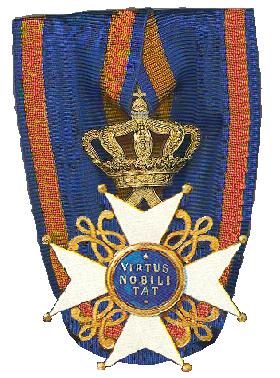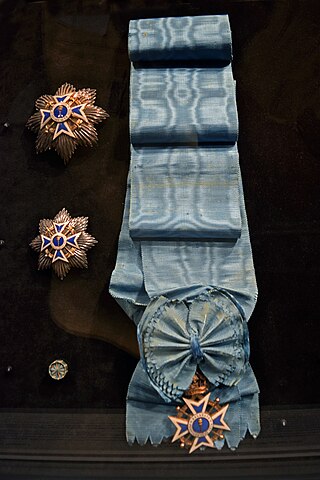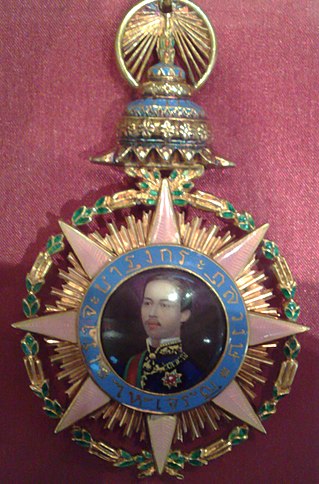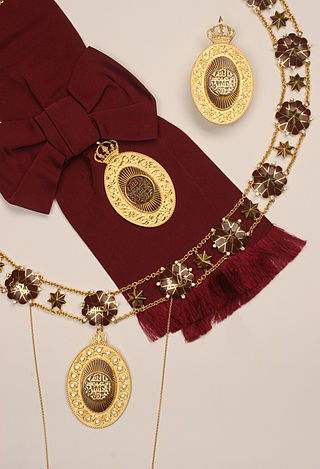
Fuad I was the Sultan and later King of Egypt and the Sudan. The ninth ruler of Egypt and Sudan from the Muhammad Ali dynasty, he became Sultan in 1917, succeeding his elder brother Hussein Kamel. He replaced the title of Sultan with King when the United Kingdom unilaterally declared Egyptian independence in 1922.

The Royal Victorian Order is a dynastic order of knighthood established in 1896 by Queen Victoria. It recognises distinguished personal service to the monarch, members of the royal family, or to any viceroy or senior representative of the monarch. The present monarch, King Charles III, is the sovereign of the order. The order's motto is Victoria. The order's official day is 20 June. The order's chapel is the Savoy Chapel in London.

The Order of the Dannebrog is a Danish order of chivalry instituted in 1671 by Christian V. Until 1808, membership in the Order was limited to fifty members of noble or royal rank, who formed a single class known as White Knights to distinguish them from the Blue Knights who were members of the Order of the Elephant. In 1808, the Order was reformed and divided into four classes. The statute of the Order was amended in 1951 by a Royal Ordinance so that both men and women could be members of the Order. Today, the Order of the Dannebrog is a means of honouring and rewarding the faithful servants of the modern Danish state for meritorious civil or military service, for a particular contribution to the arts, sciences or business life, or for working for Danish interests.

The Order of Leopold is one of the three current Belgian national honorary orders of knighthood. It is the oldest and highest order of Belgium and is named in honour of its founder, King Leopold I. It consists of a military, a maritime and a civil division. The maritime division is only awarded to personnel of the merchant navy, and the military division to military personnel. The decoration was established on 11 July 1832 and is awarded by Royal decree.

The Order of Orange-Nassau is a civil and military Dutch order of chivalry founded on 4 April 1892 by the queen regent, Emma of the Netherlands.

The Order of the Netherlands Lion, also known as the Order of the Lion of the Netherlands is a Dutch order of chivalry founded by William I of the Netherlands on 29 September 1815.

The Order of the House of Orange, sometimes referred to as the House Order of Orange, is a dynastic order of the House of Orange-Nassau, the royal family of the Netherlands similar to the Royal Victorian Order in the United Kingdom. The order was instituted by Queen Wilhelmina of the Netherlands on 19 March 1905 and is not subject to ministerial responsibility or influence, but is awarded at the discretion of the Dutch monarch alone.

The Royal Norwegian Order of Saint Olav is a Norwegian order of chivalry instituted by King Oscar I on 21 August 1847. It is named after King Olav II, known to posterity as St. Olav.

The Order of Beneficence is an order of Greece which was established in 1975 by law no.106/1975, using the same name and same insignia as that of the order instituted in the previous governance of the Kingdom of Greece, although a separate order with different statutes. It is conferred by the President of the Republic as a moral reward for women especially, Greek or foreigner who have contributed good services to the country. The fact that the order is awarded to women does not mean that the other Greek decorations are awarded exclusively to men.

The Ancient and Most Noble Military Order of the Tower and of the Sword, of the Valour, Loyalty and Merit, before 1910 Royal Military Order of the Tower and Sword, is a Portuguese order of knighthood and the pinnacle of the Portuguese honours system. It was created by King Afonso V in 1459. The order may be bestowed on people or on Portuguese municipalities.

The Royal Order of George I is a Greek order instituted by King Constantine I in 1915. Since the monarchy's abolition in 1973, it has been considered a dynastic order of the former Greek royal family.

The Royal Order of Kalākaua I was instituted on 28 September 1874 by King Kalākaua I to commemorate his accession to the throne of the Kingdom of Hawaiʻi on 12 February 1874.

The Order of the Nile was established in 1915 and was one of the Kingdom of Egypt's principal orders until the monarchy was abolished in 1953. It was then reconstituted as the Republic of Egypt's highest state honor.

The Most Illustrious Order of Chula Chom Klao was established on 16 November 1873 by King Rama V of The Kingdom of Siam to commemorate the 90th Jubilee of the Chakri Dynasty and bears his name. The pink colour reflects the Tuesday birthday colour for King Rama V.

The Most Admirable Order of the Direkgunabhorn was established by King Bhumibol Adulyadej on 22 July 1991 to be bestowed upon those who have rendered devotional services to the Kingdom of Thailand. The title Direkgunabhorn roughly translates as "Noble Order of Abundance and Quality".

The Order of King Abdulaziz is a Saudi Arabian order of merit. The order was named after Abdulaziz Al Saud, founder of the modern Saudi state.

The Japanese honours system is a system implemented for rewarding awards to Japanese and non-Japanese persons for their achievements and service to Japan. The Emperor is the head of the honors system in Japan.

The Honorary Order of the Yellow Star is the highest state decoration of the Republic of Suriname. The Order was instituted in 1975 at the independence of Suriname and replaced the Dutch Order of the Netherlands Lion. It is awarded to individuals for their meritorious service to the Surinamese people or nation. Foreigners are also eligible to receive the order. The president of Suriname is the Grand Master of the order.

The Order of al-Hussein bin Ali is the highest order of the Kingdom of Jordan. It was founded on 22 June 1949 with one class by King Abdullah I of Jordan with the intended recipients being foreign heads of state and senior royals.




















